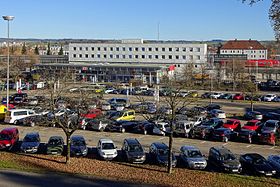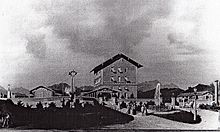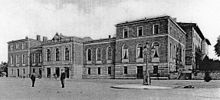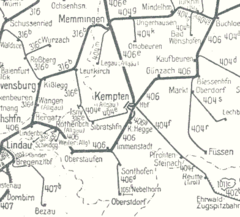Kempten (Allgäu) main station
| Kempten (Allgäu) main station | |
|---|---|
|
Reception building with station square
|
|
| Data | |
| Location in the network | Separation station |
| Platform tracks | 5 |
| abbreviation | MKP |
| IBNR | 8000197 |
| Price range | 3 |
| opening | 1852/1969 |
| Website URL | BEG station profile |
| location | |
| City / municipality | Kempten (Allgäu) |
| country | Bavaria |
| Country | Germany |
| Coordinates | 47 ° 42 '42 " N , 10 ° 19' 4" E |
| Height ( SO ) | 705 m |
| Railway lines | |
|
|
| Railway stations in Bavaria | |
Location of the former and current main train station in Kempten |
Kempten (Allgäu) Hauptbahnhof (officially: Kempten (Allgäu) Hbf , abbreviation according to the operating point directory MKP , station number (IBNR) (80) 00197) is a junction for the Illertalbahn , the Bavarian Allgäubahn and the Ausserfernbahn in Kempten (Allgäu) . The first Kempten main station was built in 1852 as a terminus station close to the city center ; In 1969 it was replaced by a through station elsewhere. The old building was demolished a few years after it was closed. The Kempten (Allgäu) Ost train station is located in the east of the city .
history
Terminal station between 1852 and 1969
The first Kempten station was built during the construction of the Ludwig-Süd-Nord-Bahn , which opened on April 1, 1852 between Kaufbeuren and Kempten and was extended from Kempten to Immenstadt on May 1, 1853 . On the one hand, the train station should be as close to the city center as possible, and on the other hand it was only possible to cross the deeply cut Iller breakthrough at a reasonable cost at a narrow point one kilometer south of the city, so a terminal station was created that served both passenger and freight traffic . In 1853 the station was equipped with a house known as the "administration building", a covered house platform, a boarding hall and a goods shed. The "administration building" had three full floors and a mezzanine ; the gently sloping purlin roof picked up on the traditional construction of the foothills of the Alps. The "unusually high-stilted structure" was typical of many functional buildings from the early days of the industrial revolution .
The commissioning of the Illertalbahn to Neu-Ulm on June 1, 1863 and the sharp increase in traffic led to the first modifications to the platform and track systems in 1869. Between 1885 and 1888, the Royal Bavarian State Railways redesigned the station significantly. On November 9, 1888, the new reception building, kept in the neo-renaissance style, was opened with a spacious entrance hall, three waiting rooms and a princely room . A baggage elevator connected the baggage claim area with the three platforms and five tracks. Since the towering predecessor buildings were preserved, the side wings of the reception building were designed to be three-story in order to hide the old buildings from the perspective of the station forecourt . The central building was two-story. The opening of the Ausserfernbahn to Pfronten on December 1, 1895 and the line to Isny on October 15, 1909 led to further changes to the station.
On July 1, 1907, the Kempten bypass went into operation, which was supposed to relieve the terminal station from through traffic, especially from freight trains. The bypass line connected the lines from Neu-Ulm, Kaufbeuren and Pfronten directly with the Allgäu Railway to Immenstadt. A new bridge was built over the Iller for the bypass ; The arched bridge made of stamped concrete is 155 meters long and has a main vault with a clear width of 64.5 meters, which spans the river at a height of 33 meters. To the north of the bypass bridge, two more stamped concrete bridges were built as access to the terminal station; the previously used König-Ludwig-Brücke , a timber frame construction, became a road bridge. Along the bypass a marshalling yard was built , which was used to form freight trains from Bavaria and the neighboring countries to the northeast towards Lake Constance , Switzerland and southwestern Europe and had a capacity of 1200 freight wagons per day. At the same time, the depot was relocated from the terminal station to the marshalling yard about two kilometers further south. The marshalling yard lost its national importance in 1933, as the long-distance freight trains were directed over the newly electrified Augsburg – Ulm railway line and henceforth avoided the steep Allgäu Railway.
From 1912, individual express trains were run over the bypass railway; From the winter timetable 1925/26, this applied to all express trains. Instead of the main train station, the trains stopped at the Kempten-Hegge stop set up for this purpose, from where switching trains, most recently rail buses , ran to the main train station 3.6 kilometers away.
In the 1960s, Kempten's main train station was frequented by around 10,000 passengers a day, 40% of which was through traffic, 20% was transfer traffic and 40% was local traffic. 200 passenger and 42 freight trains ran every day. In addition, 26 special rotating trains with 5,000 to 7,000 passengers passed the station every week.
Several information boards set up in 2013 ( Historischer Eisenbahnpfad Kempten ) with pictures and historical data on the area of the old terminus that is now being built are reminiscent of the old station.
Through station from 1969
In 1961 a fundamental redesign of the Kempten railway systems was decided. Economic feasibility studies have shown that the construction of a new through station required twice as high investments as the renovation of the terminal station, but would result in a considerable reduction in operational management costs. The city of Kempten expected the relocation of the station to improve the complex traffic conditions in the city center. The most favorable location for the new station turned out to be the area around one kilometer south of the terminal station, previously used for the exit group of the marshalling yard. The access routes could follow the previous route of the bypass. In order to keep the project financially viable, the Illerbrücke of the bypass should continue to be used.
Construction work began in 1965. A total of 300,000 m³ of earth was moved and 34 kilometers of track and 180 switch units were newly laid. According to the framework plan, the passenger station should include four platforms with seven tracks; the construction of the fourth platform was initially dispensed with because it was not necessary for the traffic at the time. The station building was built to the west of the platforms, the planning was based on 1500 ticket sales per day and the handling of 8.5 tons of luggage. The building, a four-storey building with 14,000 m³ of enclosed space , also accommodated the general agency of the German Federal Railroad (DB), the operations and machinery office and a restaurant with 85 seats. Particular importance was attached to the seven-meter-wide underpass to the platforms; For the first time at DB, a joint structure was created for luggage transport and passengers. The station forecourt with parking lots, bus stops and a taxi stand was connected to the Mittlerer Ring without crossing ; A new office building for the Deutsche Bundespost was built north of the square . A central track plan push-button interlocking, located south of the reception building, replaced eleven old interlockings.
The depot to the east of the passenger station was significantly reduced in size after the switch from steam to diesel traction . The two roundhouse with a total of 45 stalls were demolished. A hall built in 1938, which had previously been used to accommodate railcars , was preserved; as well as a repair hall for coaches and freight cars, in which 13,800 cars were repaired in 1968. At the end of the 1960s, the railway depot was used for 95 diesel traction vehicles, including 20 rail buses and 20 small locomotives . In 1950 there were 55 steam locomotives in Kempten. As a result of the change in traction, the number of employees in the depot fell from 269 to 170 people.
After the passenger station went into operation on September 28, 1969, a new local freight facility was built east of the depot , consisting of two open loading tracks and a freight hall, which was dimensioned to handle 110 tons of general cargo per day. In addition, a transfer system for road scooters and a transshipment point for containers were built.
The redesign of the station, completed in 1972, cost a total of 39.7 million DM . The city of Kempten took over DM 4.1 million of this; the state of Bavaria participated in the financing by means of a low-interest loan to the DB for 21 million DM. When selling the 10.1 hectare area freed up by the abandonment of the terminus , the DB achieved proceeds of 7.4 million DM.
The old terminus was demolished; the Kempten-Hegge stop ("Kempten bei Hegge") was also closed after the new main station went into operation. Where the station area used to be, there is now a school complex (vocational schools, technical and vocational high school, business school) and, since 2003, a shopping center ( Forum Allgäu ) and the BigBOX Allgäu event hall . An old driving axis is reminiscent of the former station exit; names such as train station pharmacy and train station hotel have also been preserved at the former location of the terminus. The Illerbrücke at the station access was converted into a road bridge; the König-Ludwig-Brücke , previously used as a road bridge , was converted for cyclists and pedestrians.
Renovations at the through station were completed in 2005.
Infrastructure
From the bus stops on the forecourt of the main train station, various bus lines run by the Verkehrsgemeinschaft Kempten run to the city center and the surrounding communities and cities. The station building was renovated and modernized in 2008. It houses three ticket offices and five ticket machines. Various shops have also rented the adjoining rooms. The main entrance is from the west, where the bus and taxi connections are also located. There is also parking available there. To the east of the platforms there are permanent parking spaces, from which direct access to the platform underpass is possible.
Tracks
The tracks at Kempten Central Station are generally used as follows:
| track | Length in m | Height in cm | Type of traffic | direction | route |
|---|---|---|---|---|---|
| 1 | 330 | 38 | Local transport | Lindau / Oberstdorf | Allgäubahn |
| 2 | 417 | 38 | Near and
Long-distance transport |
Memmingen / Hanover | Illertalbahn |
| 3 | 417 | 38 | Local and long-distance transport | Lindau / Oberstdorf / Zurich | Allgäubahn |
| 4th | 439 | 38 | Local and long-distance transport | Munich / Augsburg / Memmingen / Hamburg-Altona | Allgäubahn / Illertalbahn |
| 5 | 439 | 38 | Local transport | Pfronten / Steinach / Reutte (T) | Ausserfernbahn |
Long-distance and regional transport
The following long-distance and regional lines serve the Kempten main station:
| Line / type of train |
route | Clock frequency |
|---|---|---|
| IC 26 |
Nebelhorn: Hamburg - Hanover - Göttingen - Kassel-Wilhelmshöhe - Würzburg - Augsburg - Buchloe - Kempten - Immenstadt - Sonthofen - Oberstdorf |
a pair of trains |
| IC 32 /RE |
Allgäu: Dortmund - Essen - Düsseldorf - Cologne - Koblenz - Mainz - Mannheim - Heidelberg - Stuttgart - Ulm - Memmingen - Kempten - Immenstadt - Sonthofen - Oberstdorf |
a pair of trains |
| EC 88 | Munich - Buchloe - Kempten - Lindau - Zurich | a pair of trains |
| ALX | Munich - Kaufering - Buchloe - Kaufbeuren - Kempten - Immenstadt - Lindau / Oberstdorf | Every 2 hours |
| RE |
Allgäu-Franken-Express : Nuremberg - Augsburg - Buchloe - Kaufbeuren - Kempten - Immenstadt - Lindau / Oberstdorf |
Every 2 hours |
| RE | Augsburg - Buchloe - Kaufbeuren - Kempten - Immenstadt - Lindau / Oberstdorf | |
| RE | Ulm - Memmingen - Kempten (- Immenstadt - Oberstdorf / Röthenbach (Allgäu) (- Lindau / Wangen (Allgäu) )) | Hourly |
| RE | Munich - Geltendorf - Kaufering - Buchloe - Kaufbeuren - Kempten | Every 2 hours |
| RB | Kempten - Pfronten-Steinach (- Reutte) | Hourly |
| RB | Kempten - Memmingen - Mindelheim | once a day |
Individual evidence
- ↑ Query of the course book route 970 at Deutsche Bahn.
- ↑ Query of the course book route 975 at Deutsche Bahn.
- ↑ Query of the course book route 976 at Deutsche Bahn.
- ↑ Böttcher, through station , p. 327.
- ^ Manfred Berger : Historic train station buildings. (Volume III: Bavaria, Baden, Württemberg, Palatinate, Nassau Hesse). Transpress, Berlin 1988, ISBN 3-344-00267-8 , p. 31.
- ↑ Building description see Berger, Bahnhofsbauten , p. 31f.
- ↑ Böttcher, Durchgangsbahnhof , p. 330. See also: Illerbrücken Kempten. In: Structurae (accessed December 23, 2010).
- ↑ Böttcher, through station , p. 328.
- ↑ Berger, Bahnhofsbauten , p. 32.
- ↑ For figures see Böttcher, Durchgangsbahnhof , p. 328.
- ↑ Information boards on the history of the railway in Kempten are inaugurated. ( Memento of the original from September 21, 2013 in the Internet Archive ) Info: The archive link was inserted automatically and has not yet been checked. Please check the original and archive link according to the instructions and then remove this notice. In: allin.de, September 20, 2013.
- ↑ For figures see Böttcher, Durchgangsbahnhof , p. 329f.
- ↑ For figures see Böttcher, Durchgangsbahnhof , p. 337.
- ↑ Pictures of special trains for the commissioning of the passenger station at: Drehscheibe Foren - Kempten Hbf. November 10, 2005, accessed on June 15, 2010 .
- ↑ For figures see Böttcher, Durchgangsbahnhof , p. 329.
- ↑ Forgotten railways - old Iller bridge. May 2007, accessed June 15, 2010 .
- ↑ a b Platform information about the Kempten / Allgäu Hbf train station ( memento of the original from April 2, 2016 in the Internet Archive ) Info: The archive link has been inserted automatically and has not yet been checked. Please check the original and archive link according to the instructions and then remove this notice. on deutschebahn.com.
literature
- Reinhold Breubeck: Kempten railway junction (Allgäu) . The railway in Oberallgäu and Ausserfern. Eisenbahn-Fachbuch-Verlag, Neustadt / Coburg 2005, ISBN 3-9807748-9-9 .
- Karl-Heinz Böttcher: The new through station in Kempten (Allgäu) . In: Railway technical review . No. 18 , 1969, ISSN 0013-2845 , pp. 327-338 .
Web links
- Tracks in service facilities (MKP) , DB Netz AG (PDF)







